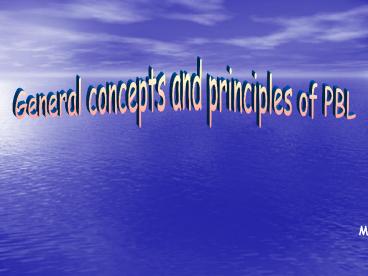??????????????????????? PBL ???????????????????????????????? - PowerPoint PPT Presentation
1 / 40
Title:
??????????????????????? PBL ????????????????????????????????
Description:
General concepts and principles of PBL. ?????????????????????????? ? ... (Cell&tissue, Embryology,Genetics) Basic Medical Science (Immunology,Infection,Inflaammation) ... – PowerPoint PPT presentation
Number of Views:45
Avg rating:3.0/5.0
Title: ??????????????????????? PBL ????????????????????????????????
1
General concepts and principles of PBL
??????? ????????????, ??.,MHPEd ?????????????
????????????????????
2
?????????????????????????? ???????
- ???????
- ???????
- ??????
- ?????????????????????????
3
?????????????????????????????????
- ??????????????????
- ???????????????????????????????
??????????????????????????????? - ?????????????????????????????? ???????????????????
4
????????????(???)???????? ???????????????????
???????
5
Average Retention Rate
The Learning Pyramid
Lecture
5
10
Reading
Audiovisual
20
Demonstration
30
Group discussion
50
Practice by doing
75
Teach others
80
National Training Laboratories, Bethel, Main,USA
6
????? Clinical
Clinical science
Basic science
Premed
7
History of PBL
- 1950s Case Western Reserve University (USA)
- 1969 Med School of McMaster (Canada)
- Maastricht (Netherlands)
- Newcastle (Australia)
- Ismailia (Egypt)
- Harvard (USA)
- Sains (Malaysia)
8
- Thailand
- 1987 Chulalongkorn
- Thammasat
- Khon Khaen
- 1990 Prince of Songkla (Modified)
- Prince of Songkla (Full)
- 2005 Chiang Mai
- etc
9
- Other Health Sciences
- Environmental Sciences
- Economics
- Law
- Engineering
- etc
10
Traditional PBL Teacher-centered
Student-centered Transfer of knowledge Acquisiti
on Giving answers Asking questions Listening
to teachers Interacting Building
blocks Holistic Departmental
control Integrated
11
Systemic approach
- Intro.to medical science
- (Celltissue, Embryology,Genetics)
- Basic Medical Science
- (Immunology,Infection,Inflaammation)
- Hematopoietic and Lymphatic System
- Nervous System and special sense
- Musculoskeletal System
12
Systemic approach
- Gastrointestinal System and Nutrition
- Cardiovascular System
- Respiratory System
- Endocrinology System
- Integumentary System
- KUB System
- Reproductive System
13
Weekly Schedule
Mon Tue Wed Thu Fri
8-9 Lect Lect
9-12 PBL SDL SDL SDL SDL
13-16 SDL SDL Lab Clin practice PBL
Faculty of Medicine ,PSU
14
PBL is the learning that results from the process
of working toward the understanding or solution
of a problem. (Barrows and Tamblyn,
1980)
15
PBL ?
- Problem-Based Learning
- Clinical Reasoning Process
- Self-Directed Learning
- Small Group Learning
16
Problem
Self-directed
Small group
17
What is a Problem/case?
A series of phenomenon in relation one to the
other that demand explanation
18
You have been playing a game of tennis. Youve a
red face and are wet all over your body. How
can these phenomena be explained?
The heat-regulating mechanism of the human
body
19
Characteristics of Problems
- Relevant, realistic, logical
- An appropriate level of complexity
- Stimulate thinking and discussion
- Interesting
- Well-organized and accurate
20
Characteristics of small group
- 7-8 students
- Actively participate in discussion
- Commit to self-directed learning
- Interpersonal behavior
- co-operative
- equal distributed function
- accepting,non-threatening
21
SDL is
- Self study
- ..Assignment
- ..Teacher way out
- ..Do whatever students want
22
Key elements of SDL
- The learner takes initiative for
- Diagnosing learning needs
- Formulating goals
- Identifying resources
- Implementing appropriate activities
- Evaluating outcomes
23
Role of facilitator
- Acknowledge the process of PBL
- Understand the course objectives
- Commit to student-directed learning
- Facilitate discussion and critical
- thinking to identify learning objectives
- Process rather than content expert
24
PBL Process
Step 1 Clarify terms and concepts Step 2
Define the problem Step 3 Analyze the
problem Step 4 Make various explanations/hypothe
sis Step 5 Formulate learning objectives Step 6
Independent study Step 7 Synthesize and test
acquired information (Schmidt and
Bouhuijs, 1980)
25
During a hard cough this morning I suddenly
tasted blood in my mouth. As this has occurred
more often these past few weeks, Im become a bit
anxious.
26
Draught
Irritated or inflammed mucous membrane
Smoking
An obstruction
CA lung
Tuberculosis
Coughing reflex
Blood vv rupture
Explosive expulsion of air causes damage
Blood in the mouth
27
Traditional teacher PBL facilitator
Enjoy authority mastery Discard
authority Center on contents On students
need Value achievement Process and end
goal Privilege theory Value application
28
Factor affecting the quality of PBL
- Quality of problems
- Group function
- Tutor performance
- Skills training
- Learning resources
29
Student Assessment
- Students performance in small group
- MCQ
- Extended matching item
- Modified essay question (MEQ)
- Objective structured clinical exam (OSCE)
- Triple jump
- Progress test
- Portfolio assessment
30
(No Transcript)
31
Advantage of PBL
- Acquiring knowledge that can be retrieved and
applied - Learning to learn (self-directed)
- Learning to analyze and solving problems
-
(Barrows,1984)
32
Advantage of PBL
- More enjoyable for students and teacher
- Learning environment is more stimulating and
humane - Promote deeper rather than superficial learning
33
Advantage of PBL
- Promote interaction between students and faculty
- Promote interdepartmental collaboration
- Improve motivation to learn
34
Disadvantage of PBL
- Teachers roles
- Depend on students disciplining themselves
- Detriment of learning in the basic science
- Stress on problem-solving skill, not
acquisition of knowledge - Require considerable time to understand the
terminology, sign symptoms, anatomy,
physiology etc -
(BarrowsTamblyn,1980)
35
Disadvantage of PBL
- Difficult for students to identify with a good
teacher - Dose not motivate faculty to share knowledge
- Cost of implementing
36
?????????????????.????????????????????????????????
?????????????????????????
????????? ????????????????????????????????????
????????????????????
???????? ?????????????????? ??????????????????
?? ????????????????????????????????
37
????????? PBL???????????????????????????????? ??
??????????????????????????????? ????????????????
?????????? ?????????????????????????????? ????
?????????????? ????????????????? ???????????????
??????????? ????????????????????????????????????
???????? ????
????? ???????????????????? ???????
??????????????????
?????,???????,????????,2001
38
Teaching Load of PBL facilitators for hybrid PBL
curriculum
80 PBL 20 lecture Sem1 13 wks in yr 2 9 wks
in yr 3 Sem2 8 8
Staff Semester1 Semester2 Non-clinician 25.9
25.0 hr/person/sem Clinician 11.2 9.2
hr/person/sem Haadyai 6.9 6.0
hr/person/sem
Arnuparp Suwannapa,2001
39
Impact of training PBL facilitators and
perception of facilitatorsroles
Perception -Effective in helping students attain
the learning objective -Valued the
effectiveness of PBL as a teaching
paradigm -Positive for facilitators roles
Concern -Lack of knowledge of specific clinical
problems -Relationship between teachers
and students
Arnuparp Rasikorn,2001
40
Thank You































